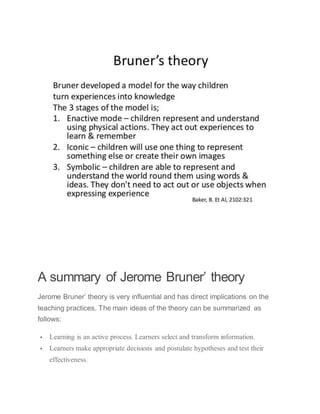
Jerome Bruner's influential learning theory summarized
- 1. A summary of Jerome Bruner’ theory Jerome Bruner’ theory is very influential and has direct implications on the teaching practices. The main ideas of the theory can be summarized as follows: Learning is an active process. Learners select and transform information. Learners make appropriate decisions and postulate hypotheses and test their effectiveness.
- 2. Learners use prior experience to fit new information into the pre-existing structures. Scaffolding is the process through which able peers or adults offer supports for learning. This assistance becomes gradually less frequent as it becomes unnecessary. The intellectual development includes three stages. The enactive stage which refers to learning through actions. The iconic stage which refers to the learners use of pictures or models. The symbolic stage which refers to the development of the ability to think in abstract terms. The notion of spiral curriculum states that a curriculum should revisit basic ideas, building on them until the student grasps the full formal concept. Although extrinsic motivation may work in the short run, intrinsic motivation has more value Implications on the learning process Bruner’s learning theory has direct implications on the teaching practices. Here are some of these implications: 1. Instruction must be appropriate to the level of the learners. For example, being aware of the learners’ learning modes (enactive, iconic, symbolic) will help you plan and prepare appropriate materials for instruction according to the difficulty that matches learners’ level. 2. The teachers must revisit material to enhance knowledge. Building on pre-taught ideas to grasp the full formal concept is of paramount importance according to Bruner. Feel free to re-introduce vocabulary, grammar points, and other topics now and then in order to push the students to a deeper comprehension and longer retention. 3. Material must be presented in a sequence giving the learners the opportunity to: a. acquire and construct knowledge, b. transform and transfer his learning.
- 3. 4. Students should be involved in using their prior experiences and structures to learn new knowledge. 5. Help students to categorize new information in order to able to see similarities and differences between items. 6. Teachers should assist learners in building their knowledge. This assistance should fade away as it becomes unnecessary. 7. Teachers should provide feedback that is directed towards intrinsic motivation. Grades and competition are not helpful in the learning process. Bruner states that learners must “experience success and failure not as reward and punishment, but as information”
